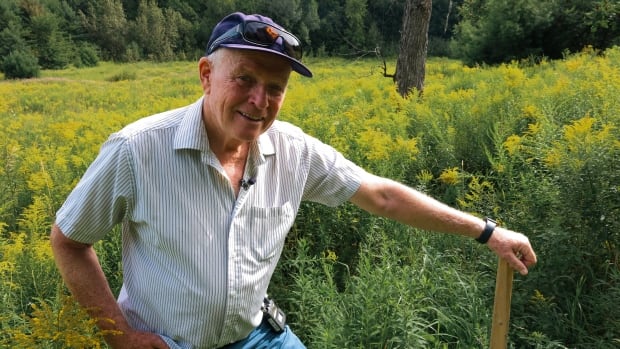Disease-resistant seedlings of an endangered tree species are doing well during their first season in a western Quebec forest, according to the conservation group that planted them.
Butternut trees are native to Canada and can be found in Ontario, Quebec and New Brunswick. But over the last 30 or so years, canker disease has wiped out 80 per cent of them, said Stephen Woodley, president of Action Chelsea for the Respect of the Environment (ACRE).
“In the region, it’s been deadly for butternuts. That’s the reason it’s endangered,” said Woodley, who helped plant their first batch of seedlings in May in the Hundred Acre Wood in Wakefield, Que.
“We got 30 conservation volunteers out to help us plant these trees, and we told them that they’re their babies for the summer. And so they’ve been going out and watering them whenever it gets dry.”
According to Woodley, the young trees are currently in good shape.

Lengthy process to recovery
One of ACRE’s sources for the disease-resistant trees was the Forest Gene Conservation Association (FGCA), one of many groups that have been working to restore the butternut population.
The group has been working for two decades to create orchards of trees that are tolerant to the fungus, said chief executive officer Kerry McLaven.
Once a healthy butternut tree is found, its twigs can be grafted onto walnut trees, McClaven said. They’re then tended to in a nursery before being planted and managed in an orchard.
The work doesn’t stop there, though: the FGCA then cares for the hybrids so that they can produce canker-resistant seeds, which are then grown into seedlings and replanted in places like the Hundred Acre Wood.
McLaven says over the years she’s been involved with the organization the political, environmental and social side of the work has changed.
“[It’s] partly due to COVID, but also … people really want to get involved in species recovery and they want to do good by the environment,” she said.
That burgeoning interest has encouraged them “to do more, to get more seed, to get it out there and start recovering the species,” she said.
While the canker is detected everywhere in Ontario, McLaven said there are also “other factors” that have also reduced the butternut population.
“Some of that has to do with land and development where these tree species will persist,” she said. “And so just all these factors together are making this tree species a species at risk.”
Lack of protections worry some advocates
According to Tony Morris, conservation policy and campaigns director with Ontario Nature, more needs to be done at a government level to safeguard the species.
“You can’t really recover a species [when] you’re allowing exemptions to destroy their habitat,” said Morris.
Morris cited the fact that butternut is one of the species in Ontario that a developer could can cut down or otherwise remove as long as they pay into a fund.
The measure — which was called a “pay-to-kill” provision by Green Party of Ontario Leader Mike Schreiner when it was proposed in 2019 — was quickly opposed by environmentalism groups. It was later passed in 2021.
“The problem with this fund is it’s not tied to the impacted species and there’s no requirement that the fund will be used to compensate where the harm occurs,” said Morris.
At the time, the province said the butternut was endangered because of the canker disease, and if developers simply had to plant more of them it wouldn’t help the species recover.
As for ACRE, it plans to plant 20 more butternut trees in Wakefield this fall — alongside other native and endangered plants.






